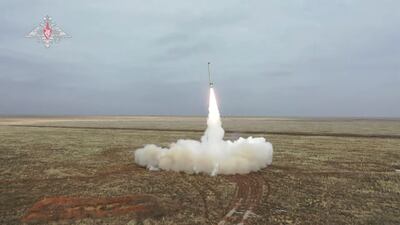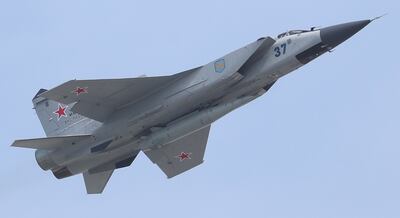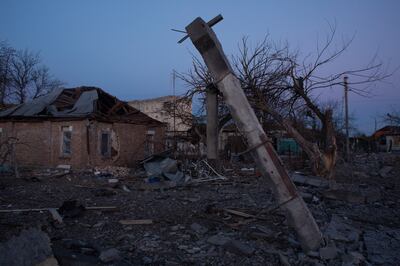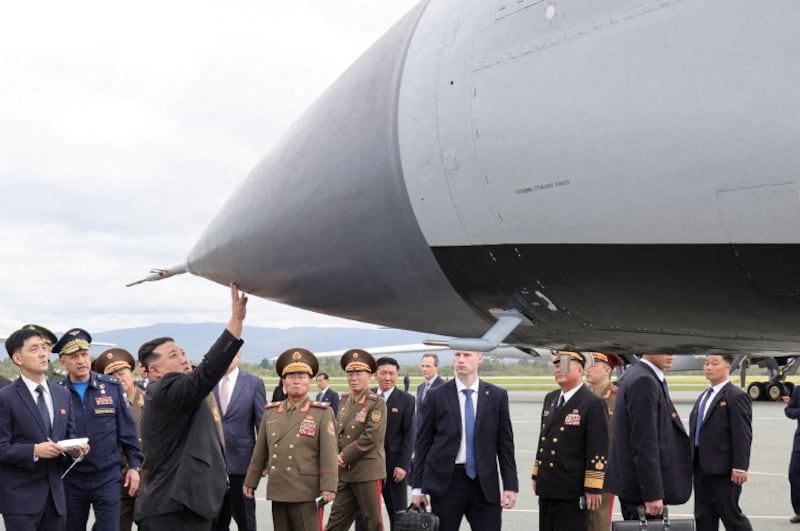When Kim Jong-Un paid his recent visit to Russia on a tech-fishing mission he was spotted admiring a Kh-47M2 Kinzhal missile.
The weapon can fly down at a target at 10,000kph carrying a 480kg explosive or a nuclear warhead.
The Kinzhal, which means “dagger”, accelerates at exceptionally high speed on its terminal phase allowing it to penetrate bunkers, and has a range of up to 2,000km when air launched.
The North Korean leader's visit fuelled growing concerns that Moscow will secretly export its advanced technology, including the nuclear-capable hypersonic missile.
It is a weapon that would significantly advance Mr Kim's firepower.
“The Kinzhal combines high speed with more manoeuvrability than your typical ballistic missile,” said Dr Sidharth Kaushal, of the Rusi think tank. “It also provides high speed impact, which combined with a very large warhead makes it quite useful for penetrating hardened and buried targets.”
The Kinzhal, which reportedly costs $10 million per missile, can also go after early warning radars blinding air defences, or a nuclear armed version could be used against “high value targets”, such as aircraft carriers, he added.
Any country with the Kinzhal in their armoury would also be able to incorporate it into a “multiple-missile advanced attack” using cruise, drones and ballistic weapons, said military expert Sam Cranny-Evans.

“If you combine drones, then cruise missiles at low altitude subsonic speeds, then add in a Kinzhal flying very, very quickly that complicates that whole missile defence process further.”
Kinzhal, which is currently air-launched from an MiG-31 jet but could be adapted for ground use, also has the capability to threaten both South Korea and Japan from North Korea.
During Mr Kim’s six-day visit to Russia that ended on Sunday, he was shown the Kinzhal fitted on to nuclear-capable strategic bombers.
“It can fly from Moscow to Japan and then back again,” Defence Minister Sergei Shoigu told Mr Kim of one aircraft.
There has also been a legacy of Russia exporting arms technology to North Korea with the Scud missiles exported during the Soviet era.

Amael Kotlarski, a weapons analyst at Janes, the defence intelligence company, argued that the Kinzhal manoeuvrability would also give it an advantage in avoiding South Korea’s air defence.
“You could fly out over the Sea of Japan and come in from unexpected angles, which would complicate ballistic missile defence because clearly the South Koreans know which direction the North Koreans launch from. That would prove a significant capability for North Korea.”
Hypersonic Iskander
There is also concern that the Russian-made Iskander missile technology might be transferred.
The Iskander has proven effective against Ukraine, with its ability to deploy six decoys in its terminal phase that emulate a radar signature, as well as an infrared signature of its warhead.
It too can travel at hypersonic speed of Mach 7 (8,600kph), getting to an altitude of 50km. It carries an 800kg warhead that is accurate to within five metres and has a range of 500km.
“The Iskander would be really useful to North Korea because it is road-mobile, potentially rail-mobile and it’s difficult to intercept providing a more complex target for Patriot air defence because it can deploy countermeasures,” said Dr Kaushal.

While it was not an “Armageddon weapon,” the Iskander was “highly capable,” said Mr Cranny-Evans.
“With North Korea’s nuclear posturing it could be pretty useful. The Iskander is complex and really capable, perhaps more so than people suspected.”
Dr Kausal also suggested that the “biggest boon” to North Korea would be Russia boosting their ability to handle solid propellent rocket motors and technology that would “help them scale-up their long-range ballistic missiles”.
However, military experts suggested it would require considerable training to make the transfer happen, which would also be in strict violation of UN sanctions on North Korea.







